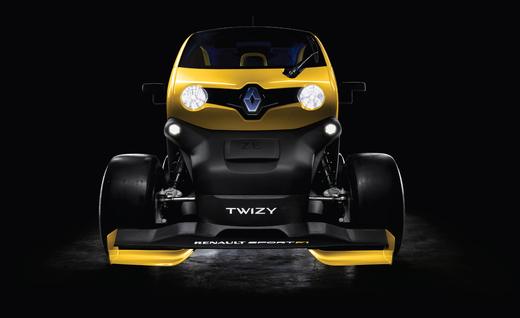Twizy Renault Sport F1 Concept Car
To say that Renault engineers have too much time on their hands might be an understatement. The engineering team has come out with the Twizy EV Sport F1 Concept Car, a car that features a Kinetic Energy Recovery System (KERS) used in the Renault-powered Formula 1 race cars.
Renault’s Twizy, for those not aware, is a tiny electric city car with tandem seating for two. It is sold only overseas at the moment. In standard form, it’s powered by a 17-hp electric motor and has a top speed of 53 mph.
The new Twizy Renault Sport F1 concept version is equipped with two electric motors — the original motor (17 hp/13 kW) and the F1-style KERS motor grafted on top of that.
When the KERS is activated, Twizy Renault Sport F1’s power output climbs instantly by a factor of six, from 17 to 97 horsepower (72 kW). This boost is available for approximately 14 seconds, just as it is in the case of a Formula 1 car. Thanks to this additional power, the concept car is capable of accelerating from standstill to 68 mph.
The Twizy Renault Sport F1 offers the driver two modes to use the KERS system — these can be selected on the Formula-style steering wheel.
- Recovery mode: with this mode activated, the electric motor functions like a conventional generator, drawing power like a dynamo to convert the mechanical energy produced by the Twizy main motor into electrical energy. Up to 4kW can be siphoned off in this way to charge the battery while on the move.
- Boost mode: the energy recovered using the Recovery Mode can be re-employed whenever the driver wishes by pressing on the button located on the steering wheel. This reverses the process. Instead of serving as a generator, the KERS’ motor-generator unit (MGU-K) now functions as a motor to bring a power boost to the principal motor to which it is directly linked via the driveshaft.The MGU-K fits inside a 10 cm-diameter cylinder and can rev to as high as 36,000 rpm. The maximum power output of the MGU-K is 60 kW (approximately 80 hp). The charging process and the way the stored energy is delivered are controlled by a control unit which is itself linked to Twizy Renault Sport F1’s ECU (Electronic Control Unit).
The peak revs of the KERS and Twizy’s principal motor are 36,000 rpm and 10,000 rpm. Clearly, making a connection between the two motors was one of the big challenges faced by the engineers. To ensure Synchronisation, they used a 1:3.6 reducer gear that uses the same drive gear as that of the F1 V8 engine.
To withstand the peak revs of 36,000 rpm of the KERS system, a pressurized lubrication system was used to help the bearings. To prevent the KERS battery from overheating under constraints to which it is exposed, Twizy Renault Sport F1 is equipped with water cooling. Both of these systems are existing Renault Sport Technologies solutions.
While the Twizy Renault Sport F1 does look kind of odd, this new concept may bridge the gap between practicality and performance for a future generations of EV cars. In some ways, it’s a bit more “out there” than the Renault Twin’Z concept car, and in some ways it’s a bit more realistic. What do you think?
Chip in a few dollars a month to help support independent cleantech coverage that helps to accelerate the cleantech revolution!
Have a tip for CleanTechnica? Want to advertise? Want to suggest a guest for our CleanTech Talk podcast? Contact us here.
Sign up for our daily newsletter for 15 new cleantech stories a day. Or sign up for our weekly one if daily is too frequent.
CleanTechnica's Comment Policy
